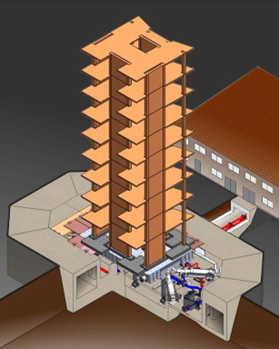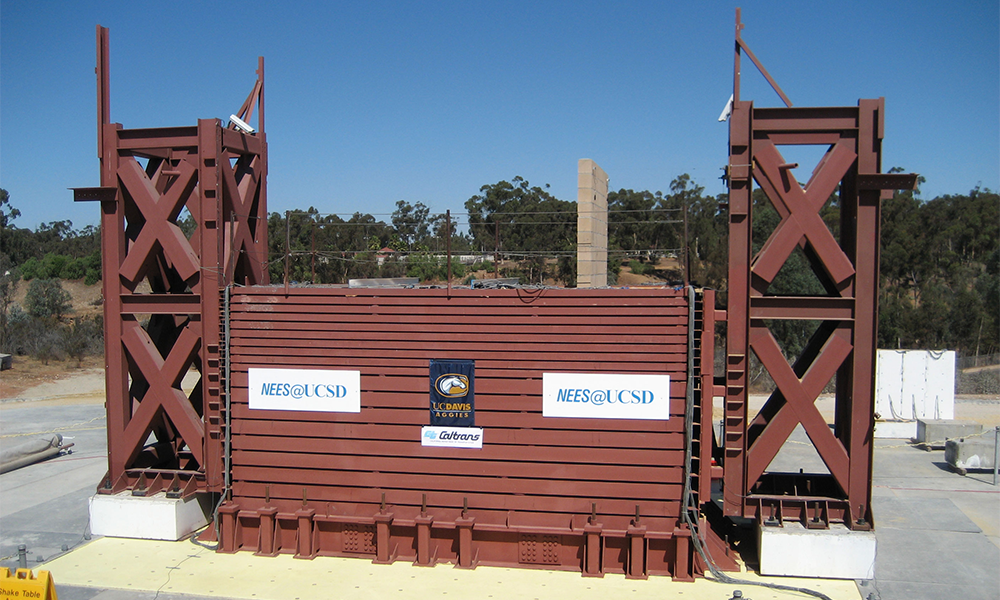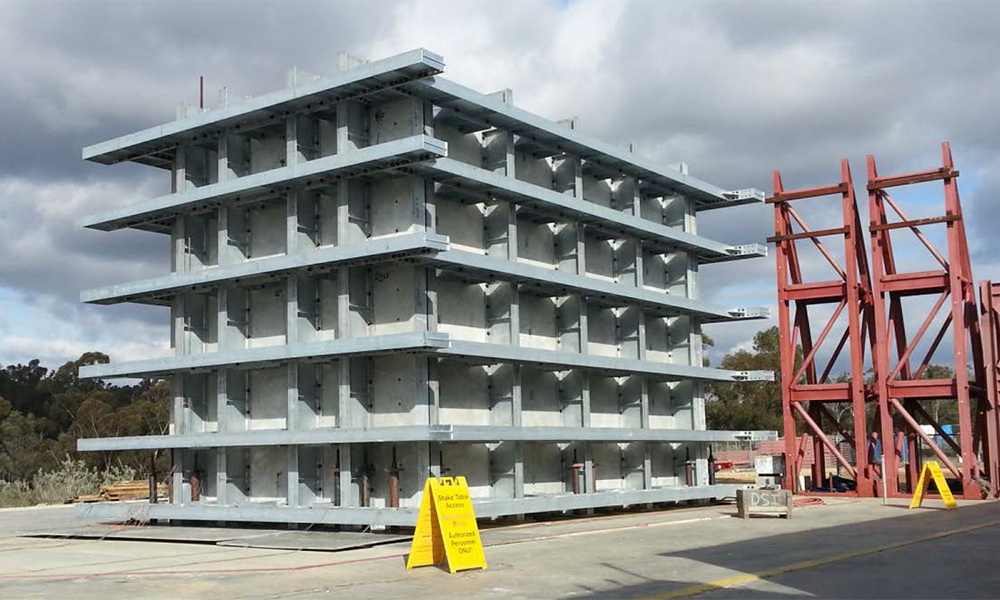The LHPOST was designed as a six-degrees-of-freedom (6-DOF) simulator but built from 2002 to 2004 as a single axis simulator to meet the funding available. This limitation prevented the investigation of important aspects of the seismic response of 3-D systems to realistic multi-directional input.
With a grant from the National Science Foundation (NSF) awarded on October 1, 2018, and additional financial resources from UC San Diego, the LHPOST was upgraded from one to six degrees of freedom (6-DOF) capabilities and renamed the LHPOST6. The upgrade was designed between October 2018 and September 2019 and built from October 2019 to March 2022. The LHPOST6 became operational on April 12, 2022, and is now the largest shake table facility in the US and possesses the largest payload capacity globally.
LHPOST6 is a unique outdoor shake table facility that can accurately reproduce far- and near-field ground motions for the seismic testing of large structural, geotechnical or geostructural systems, or soil-foundation-structural (SFS) systems, up to a weight of 20 MN. A schematic of the LHPOST6 mechanical and servo-hydraulic components is shown in the accompanying figure.
View live feed:

Specifications for LHPOST6
The state-of-the-art data acquisition (DAQ) system consists of 12 nodes with 64 channels each (for a total of 768 measurement channels) at 24-bit Analog-to-Digital resolution, simultaneous sampling, and a sampling rate up to 25.6 kS/sec per channel. Each node consists of a chassis with a PXI Express backplane that houses the power supply, controller, timing and synchronization module, and the signal conditioning modules (see Figures 1 and 2 in Final Report Supplemental Figures). The signal conditioning modules also support communicating with Transducer Electronic Data Sheet (TEDS) enabled sensors allowing for the use of advanced sensors in the future. Each DAQ node also includes three rack-mounted terminal blocks to connect sensors. Each terminal block supports connectivity to three signal conditioning modules allowing for the connection of up to 64 sensors per DAQ node. This DAQ provides superior aliasing rejection with user-configurable digital anti-aliasing filters and zero skew time between different channels due to simultaneous sampling, thus enabling accurate recordings from very small (ambient vibrations) to very large (seismic testing) motions.
The 12 DAQ nodes are networked locally through an intranet for synchronization. A trigger line from the shake table controller (MTS 469D) is connected to both the camera system and each DAQ node. When the shake table is operated during a test, a signal is sent to the camera system and the DAQ intranet network simultaneously triggering the recording of all connected sensors and cameras for a fully synchronized and automated data package.
The LHPOST6 can be used in combination with either a 3 m wide by 6.7 m long by 4.7 m high large laminar soil box, funded by Caltrans, or a 4.6 m or 5.8 m wide by 10 m long by 7.6 m high large soil confinement box (LSCB), funded by NSF. Both soil boxes are modular and can be configured to a given height. The soil confinement box can be configured in two different widths. These large soil boxes enable large-scale seismic experiments on geotechnical and SFS systems.


Similar to the LHPOST uniaxial system, the LHPOST6 includes the basic hardware and software necessary for real-time hybrid shake-table (RTHST) testing. However, RTHST was not in the scope of the 6-DOF upgrade of the LHPOST and would require some memory mapping and user-interface software updates to make visible the various system channels required for RTHST. The basic functionality for RTSHT was verified with the uniaxial configuration in commissioning tests in 2017. Besides the LHPOST uniaxial system, the other Structural Testing RTHST hardware and control equipment used consisted of a 500 kN, ±203 mm dynamic actuator, a four-channel MTS FlexTest controller, and a SCRAMNet ring for real-time communication and synchronization of data flow between the shake-table controller, FlexTest controller, and Simulink Real-time Target PC. Numerical substructures can be programmed in Simulink for hard real-time implementation or in OpenSees using high-performance computers capable of extending application to complex structural models. The OpenSees/OpenFresco open-source software framework for hybrid simulation implemented in the LHPOST is readily extendable to 6-DOF shake table substructure testing. The Structural Testing RTHST controller hardware and software mentioned above were purchased in 2009 and would need to be upgraded to work with the new LHPOST6 configuration. In addition to this significant upgrade, research on RTHST testing using small and medium size multi-directional shake tables (such as the one built at the NHERI Lehigh Experimental Facility) must be conducted before RTHST testing can be safely implemented on a large shake table such as the LHPOST6. RTHST testing is an excellent subject of future collaborative research between the NHERI Lehigh and NHERI@UC San Diego EFs.